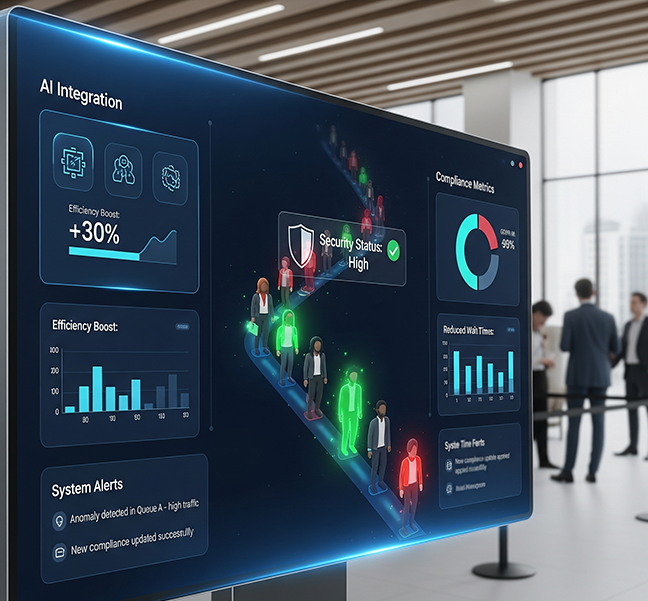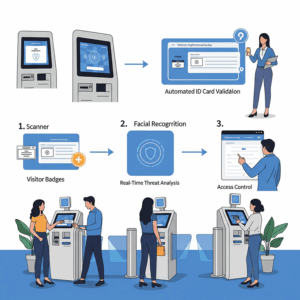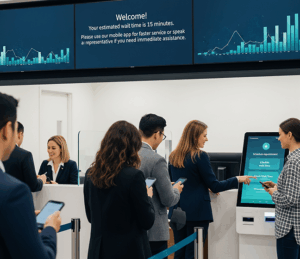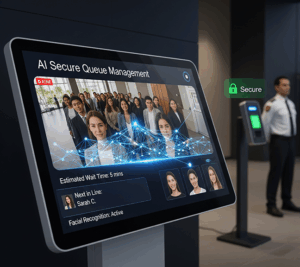
News & Updates

Integrating AI with Queue Management: Optimising Customer Flow in 2025
AI-driven queue management systems are revolutionising how organisations orchestrate customer flow and deliver services in 2025. The integration of artificial intelligence with queue management is now a strategic necessity for sectors ranging from healthcare and government to retail and finance. By adopting intelligent queue platforms, businesses can achieve real-time resource optimisation, dramatically reduce wait times, and enhance the overall customer experience. This article examines how AI-powered queue solutions are reshaping operational landscapes, supporting compliance in regulated environments, and driving measurable improvements in both service delivery and business outcomes. Discover the latest trends, benefits, and actionable steps for implementing AI-enabled queue management systems that align with your organisation’s goals and create lasting value for your stakeholders.
Whether you oversee a hospital, manage a government service centre, or lead a retail network, the ability to handle customer traffic efficiently is crucial. AI integration delivers dynamic control over queues, predictive analytics, and automated resource allocation all while providing customers with transparency and personalised engagement. As organisations across Southeast Asia and beyond embrace digital transformation, intelligent queue management platforms are setting new standards for efficiency, compliance, and user satisfaction. Read on to explore how AI is redefining queue management and what it means for your business in 2025.
Real-Time Queue Orchestration with AI
Integrating AI with queue management systems enables organisations to orchestrate customer flow dynamically, adapting in real time to fluctuations in demand. This capability is particularly vital in high-footfall environments such as hospitals, government service centres, and retail branches, where operational agility directly impacts service quality and customer satisfaction. AI algorithms continuously analyse live queue data and historical trends, allowing for instant adjustments in resource allocation and service point management. As a result, bottlenecks are minimised and average wait times are significantly reduced a measurable improvement for both customers and staff.
By automating queue orchestration, organisations benefit from smarter deployment of personnel and more balanced workloads, even during peak periods or unexpected surges. The system’s real-time response to changing conditions eliminates the need for manual interventions, ensuring every customer receives timely service. In practice, this translates to smoother throughput, enhanced operational resilience, and a more positive user experience. The strategic value of AI-powered queue management lies not only in its technical sophistication but in its ability to deliver consistently high standards of service across diverse sectors.
Predictive Analytics for Demand Management
Predictive analytics powered by AI are at the heart of modern queue management. By examining both historical data and real-time activity, these systems forecast peak periods and anticipate customer flow patterns. This foresight allows organisations to proactively adjust staffing levels, open additional service counters, or redirect resources where they are needed most. In Singapore’s public healthcare sector, such predictive queue management has led to reductions in average wait times of up to 30%, directly enhancing patient satisfaction and operational efficiency.
Forecasting demand is especially critical for organisations with variable traffic, such as clinics or government agencies. With AI-driven insights, decision-makers can plan ahead, ensuring that resources are always matched to anticipated needs. This not only improves service continuity but also supports more effective staff scheduling and resource planning, contributing to overall productivity and customer trust.
Automated Resource Allocation
Queue management systems equipped with AI automate the distribution of staff and resources throughout the service environment. These platforms monitor key indicators such as queue length, service duration, and customer arrival rates, instantly reallocating personnel to busy counters as required. The automation of resource allocation ensures operational balance, maintaining throughput and preventing service delays even during high-demand events or emergencies.
For organisations managing complex, multi-branch operations, automated resource allocation brings remarkable efficiencies. Staff are deployed precisely where needed, reducing idle time and maximising productivity. The reduction in manual intervention not only streamlines operations but also frees up managerial time for strategic oversight, enabling a culture of continuous improvement and adaptability.
Enhancing Customer Experience through Intelligent Engagement
The integration of AI into queue management systems transforms the customer journey by delivering personalised engagement and seamless service touchpoints. Customers today expect convenience, transparency, and flexibility qualities that intelligent queue platforms are designed to provide. From self-service kiosks to mobile check-ins, AI-powered systems enable users to interact with queues in ways that suit their preferences and schedules, reducing uncertainty and enhancing satisfaction.
Modern queue management goes beyond basic waitlist functionality. AI tailors notifications and updates to individual customer profiles, ensuring timely and relevant communication.The result is a more informed, empowered user base and a marked improvement in feedback scores and loyalty. Organisations in retail banking, healthcare, and government services have reported substantial gains in customer satisfaction by adopting these technologies. The flexibility of omnichannel engagement and the accessibility of robotics-enabled guidance further reinforce the value of AI-driven queue systems in 2025.
Personalised Notifications and Updates
Customers benefit from real-time notifications about their queue status, delivered via SMS or dedicated mobile applications. AI customises these alerts based on service history, appointment preferences, and anticipated wait times, empowering users to manage their schedules effectively. This personalised approach has proven particularly effective in retail banking, where a 25% improvement in customer feedback scores has been observed following the introduction of intelligent notification systems.
By keeping customers informed and engaged, organisations not only reduce the anxiety associated with waiting but also foster a sense of transparency and trust. The ability to communicate proactively and adaptively throughout the customer journey is a defining feature of AI-integrated queue management, setting new standards for service excellence.
Omnichannel Self-Service Options
AI-enabled queue systems support a range of self-service interactions, including walk-in registration, online queue joining, and kiosk-based check-ins. Customers can access queue services from any device whether smartphone, tablet, or self-service terminal giving them greater control over their experience. This omnichannel approach streamlines service journeys, reduces physical congestion, and improves accessibility for users across different sectors.
Flexible self-service options are especially valuable in environments where diverse user groups require tailored solutions. Healthcare providers, government agencies, and retail chains have embraced these platforms to offer frictionless service, reduce operational overheads, and improve the overall quality of customer engagement.
Adaptive Queue Engagement with Robotics
Robotics extensions such as Q’Bot™ work in tandem with AI queue management systems to guide visitors through each stage of the process. These robots provide real-time updates, offer contactless assistance, and support accessibility for users who may be unfamiliar with digital interfaces or require special accommodations. Deployments in government agencies have demonstrated up to 40% faster queue movement and marked improvements in visitor experience, setting new benchmarks for operational efficiency and inclusivity.
By integrating robotics into customer engagement strategies, organisations signal their commitment to innovation and service quality. The presence of adaptive, intelligent robots in public spaces enhances both the practical flow of queues and the perceived value of the service environment, reinforcing brand reputation and stakeholder confidence.
Data-Driven Insights for Continuous Improvement
The synergy between AI and queue management unlocks powerful data-driven insights for operational leaders. Real-time dashboards and historical analytics provide a comprehensive view of service activity, enabling organisations to identify bottlenecks, benchmark performance, and implement process improvements. This data-centric approach fosters a culture of continuous improvement, supporting compliance with regulatory standards and enhancing organisational accountability.
With actionable intelligence at their fingertips, managers can make informed decisions about resource allocation, service redesign, and strategic planning. The ability to generate custom analytics and performance reports ensures that operational goals are met and stakeholder expectations are exceeded. Data-driven queue management is rapidly becoming a cornerstone of digital transformation efforts in sectors where efficiency and transparency are paramount.
Operational Dashboards for Live Monitoring
Supervisors have access to live operational dashboards displaying key metrics such as queue volumes, transaction times, and service durations. This visibility enables immediate responses during peak periods, including opening new counters or reallocating staff to high-demand areas. In healthcare facilities, real-time monitoring has helped manage emergency surges with minimal disruption, maintaining service quality and patient safety.
Live dashboards also serve as early warning systems, highlighting potential bottlenecks before they impact customer experience. The proactive management enabled by these tools is essential for organisations striving for operational excellence and resilience in dynamic environments.
Custom Analytics for Performance Benchmarking
AI-driven analytics track a wide range of service parameters, including average queue lengths, wait times, and user trends over extended periods. Organisations use these insights to benchmark performance, set strategic targets, and identify areas for optimisation. Custom reporting capabilities support both internal decision-making and external accountability, demonstrating commitment to transparency and continuous improvement.
Performance benchmarking is particularly valuable in regulated sectors, where operational standards must be met and reported to stakeholders. The use of advanced analytics ensures that every aspect of queue management is evidence-based and responsive to changing demands.
Strengthening Security and Compliance with AI Integration
Security and compliance are critical considerations in industries governed by stringent regulations, such as healthcare, financial services, and government operations. AI-powered queue management systems embed advanced security protocols, including encrypted data handling and robust authentication processes. These features ensure that sensitive customer information is protected and that organisations are prepared to meet the requirements of audits and compliance checks.
The integration of digital audit trails and granular access controls further supports organisational accountability, making it possible to track every queue interaction and safeguard operational integrity. By adopting AI-enabled queue platforms, organisations can operate with confidence, building trust among users and regulatory bodies while maintaining the highest standards of security and privacy.
Secure Data Management and Access Controls
AI queue management systems employ encrypted data protocols to safeguard personal and transactional information at every touchpoint. Granular access controls ensure that only authorised personnel can view or manage sensitive data, supporting compliance with international standards such as ISO/IEC 27001 and Singapore’s PDPA. This rigorous approach to data security reduces risk and builds trust with customers, partners, and regulators.
Organisations benefit from peace of mind, knowing that their queue systems are designed to prevent unauthorised access and protect against data breaches. Secure management of customer information is not just a compliance requirement but a vital aspect of maintaining brand reputation and stakeholder confidence.
Digital Audit Trails for Accountability
All queue interactions are logged in secure, tamper-proof records, creating comprehensive digital audit trails. These records facilitate swift incident reviews and regulatory audits, providing clear evidence of operational integrity and compliance. In financial services, where audit-ready systems are a baseline expectation, the ability to demonstrate transparency and accountability is essential for maintaining stakeholder trust.
Digital audit trails also support continuous process improvement, allowing organisations to analyse historical trends and refine operational strategies. The combination of real-time monitoring and retrospective analysis positions AI-driven queue management as a cornerstone of responsible, compliant service delivery in 2025.
Future Trends: AI-Driven Queue Management in Smart Cities
As cities across Southeast Asia and beyond invest in smart infrastructure, AI-driven queue management is emerging as a pivotal component of urban mobility and public service delivery. Integration with IoT sensors and cloud platforms enables real-time analysis of crowd density, predictive scheduling, and proactive management of public spaces. These trends are shaping the future of queue management, supporting efficient resource use and better citizen experiences in transport hubs, healthcare facilities, and government agencies.
The scalability of cloud-based queue platforms allows organisations to expand rapidly across multiple locations, maintaining consistent service standards and centralised oversight. Citizen-centric design principles, including multilingual support and adaptive feedback channels, ensure that AI queue solutions remain accessible and inclusive. As smart cities evolve, intelligent queue management will play a vital role in delivering safe, efficient, and responsive services to diverse communities.
IoT Integration for Real-Time Traffic Flow
Queue management platforms are increasingly connecting with IoT sensors to monitor crowd density and movement in public areas. AI systems interpret sensor data to dynamically adjust queue strategies, improving safety and efficiency across transport hubs and healthcare environments. Cities like Singapore are piloting these systems to support real-time management of complex public spaces, setting new standards for urban mobility and operational resilience.
The use of IoT-enabled queue management ensures that service delivery remains agile and responsive, even in rapidly changing conditions. This integration supports both immediate operational needs and long-term planning for smart city infrastructure.
Cloud-Based Scalability for Regional Expansion
Deploying AI queue management systems on cloud infrastructure allows organisations to scale quickly and manage operations across multiple sites. Centralised control enables consistent service standards, easy updates, and efficient resource planning, making these platforms ideal for governments, hospitals, and retail chains operating throughout Southeast Asia and beyond.
Cloud-based scalability is also critical for organisations with fluctuating demand or seasonal variations in customer flow. By leveraging cloud technology, businesses can maintain high performance and adaptability, supporting sustainable growth and regional expansion.
Citizen-Centric Design for Public Services
Future AI queue solutions will prioritise user-friendly interfaces and accessibility, ensuring equitable service for all demographic groups. Features such as multilingual support and adaptive feedback channels will enable public agencies to deliver inclusive, responsive services to diverse communities. This citizen-centric approach reinforces trust in digital transformation initiatives and supports the broader goals of smart city development.
By focusing on the needs of users, organisations can create queue management systems that are both effective and engaging, fostering a culture of continuous improvement and public satisfaction.
Integrating AI with Queue Management: Next Steps for Organisations
The integration of AI in queue management is fundamentally reshaping how organisations serve customers, optimise resources, and meet regulatory requirements. As digital transformation accelerates in 2025, intelligent queue systems deliver measurable gains in efficiency, compliance, and customer satisfaction. Businesses looking to future-proof their operations should consider adopting AI-powered queue platforms that align with strategic
objectives and provide consistent value across all touchpoints. To explore customised queue management solutions built for sustainable growth, connect with ATT InfoSoft and discover how AI can elevate your service delivery for the future.
Frequently Asked Questions (FAQ)
What is an AI-powered queue management system?
An AI-powered queue management system uses artificial intelligence to dynamically manage customer flow, predict demand, and allocate resources in real-time. It optimises wait times, enhances service delivery, and improves the overall customer experience.
How does AI improve queue management efficiency?
AI improves queue management by using real-time data analysis, predictive algorithms, and automated decision-making. It identifies bottlenecks, forecasts demand, and ensures optimal allocation of resources, leading to reduced wait times and improved operational efficiency.
What industries benefit the most from AI queue systems?
Industries such as healthcare, retail, transportation, banking, and government services greatly benefit from AI queue systems. These systems streamline operations, enhance customer satisfaction, and provide scalable solutions for managing high foot traffic.
What are the main features of AI queue management systems?
Key features include predictive analytics, real-time notifications, omnichannel self-service options, automated staff allocation, and seamless integration with other technologies like IoT and robotics.
How does predictive analytics enhance queue management?
Predictive analytics leverages historical and live data to forecast customer flow and peak demand times. This enables organisations to proactively allocate resources, adjust staffing, and improve service delivery during busy periods.
Can AI queue systems provide personalised customer experiences?
Yes, AI-powered systems personalise customer experiences by offering tailored notifications, updates, and queue management options. Customers can interact with systems via mobile apps, kiosks, or online portals, enhancing convenience and satisfaction.
Are AI queue systems scalable for large-scale operations?
AI queue systems are highly scalable and can handle large-scale operations across multiple locations. They adapt to varying customer volumes and ensure consistent performance even during peak periods.
How do AI queue systems integrate with other technologies?
AI queue systems can integrate with technologies like IoT sensors, robotics, and cloud platforms. For example, robotic assistants can guide customers, while IoT devices provide real-time data for more accurate queue management.
How do AI queue systems ensure data privacy and compliance?
AI queue systems adhere to strict data privacy protocols, including encryption, access controls, and audit trails. They comply with global regulations such as GDPR, HIPAA, and other local data protection laws to safeguard customer information.
What are the long-term benefits of implementing AI in queue systems?
Long-term benefits include continuous improvement through data-driven insights, enhanced customer loyalty, cost reduction through automated processes, and the ability to scale operations efficiently as demand grows.
Send us a message
Contact Information
Address:
35 Ubi Crescent, ATT Building, Singapore, 408585
Phone:
Email:
Website:
www.attsystemsgroup.com






